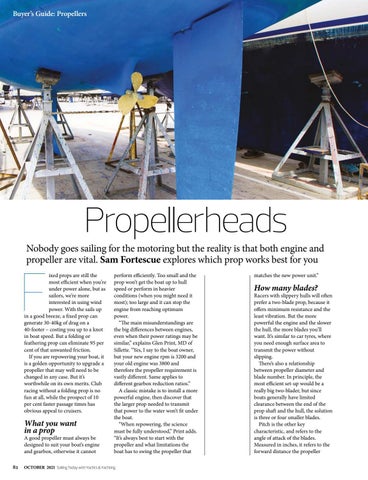Buyer’s Guide: Propellers
Propellerheads Nobody goes sailing for the motoring but the reality is that both engine and propeller are vital. Sam Fortescue explores which prop works best for you
F
ixed props are still the most efficient when you’re under power alone, but as sailors, we’re more interested in using wind power. With the sails up in a good breeze, a fixed prop can generate 30-40kg of drag on a 40-footer – costing you up to a knot in boat speed. But a folding or feathering prop can eliminate 95 per cent of that unwanted friction. If you are repowering your boat, it is a golden opportunity to upgrade a propeller that may well need to be changed in any case. But it’s worthwhile on its own merits. Club racing without a folding prop is no fun at all, while the prospect of 10 per cent faster passage times has obvious appeal to cruisers.
What you want in a prop
A good propeller must always be designed to suit your boat’s engine and gearbox, otherwise it cannot
82
perform efficiently. Too small and the prop won’t get the boat up to hull speed or perform in heavier conditions (when you might need it most); too large and it can stop the engine from reaching optimum power. “The main misunderstandings are the big differences between engines, even when their power ratings may be similar,” explains Glen Print, MD of Sillette. “Yes, I say to the boat owner, but your new engine rpm is 3200 and your old engine was 3800 and therefore the propeller requirement is vastly different. Same applies to different gearbox reduction ratios.” A classic mistake is to install a more powerful engine, then discover that the larger prop needed to transmit that power to the water won’t fit under the boat. “When repowering, the science must be fully understood,” Print adds. “It’s always best to start with the propeller and what limitations the boat has to swing the propeller that
OCTOBER 2021 Sailing Today with Yachts & Yachting
matches the new power unit.”
How many blades?
Racers with slippery hulls will often prefer a two-blade prop, because it offers minimum resistance and the least vibration. But the more powerful the engine and the slower the hull, the more blades you’ll want. It’s similar to car tyres, where you need enough surface area to transmit the power without slipping. There’s also a relationship between propeller diameter and blade number. In principle, the most efficient set-up would be a really big two-blader, but since boats generally have limited clearance between the end of the prop shaft and the hull, the solution is three or four smaller blades. Pitch is the other key characteristic, and refers to the angle of attack of the blades. Measured in inches, it refers to the forward distance the propeller













